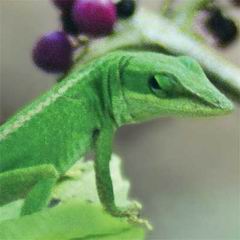November 27, 2006
Green Anole. Anolis carolinensis

Scientific Name: Anolis carolinensis
Other Common Names: American Anole, American Chameleon, Carolina Anole, Red-throated Anole
Total Length: 5-8 inches
Range: North Carolina to Florida, and then west into Texas and the West Indies.
Habitat: They can be found in thin, sunny woods, brush country, bushy ground, walls of orchards and gardens, and around areas of human habitation.
Sex Determination: Males are larger than females and have enlarged post anal scales. They also have a large, pink throat fan.
Reproduction: When a male has driven away any intruders from his territory he will try to attract the female by bobbing his head and expanding his dewlap. The female tells the male if she is receptive by dropping her head low. He will then approach her from the side and try and maneuver his cloaca as close as possible to the female’s. Mating then takes place.
[snip center][/snip]
Egg-Laying: Each female produces several clutches a year, each usually consisting of two eggs. The eggs are layed one at a time, at intervals of 3-6 weeks. They are laid in moist debris or under tree bark.
Egg Care: You should remove the eggs and put them in an incubator (which should be standing ready). Be careful not to change the position of the eggs while removing them. The embryo may be smothered by the yolk if the position of the egg is later changed.
Incubate the eggs at temperatures between 84-88 degrees F. If the conditions are right, the eggs should hatch within 2-3 months. Don’t let the eggs get too moist or they will never hatch.
Care In Captivity:
- Tank Size: A maximum of four anoles in a 10 gallon tank would be alright. To prevent fighting, there should be more females than males.
- Substrate: Zoo Med’s Repti-Bark is our favorite substrate because it is easy to clean, creates more humidity, and is natural looking. Other substrates you can use are gravel, stones, or soil.
- Decorations: You can have a log, bark, sticks, rocks, and fake plants in the tank. You can use live plants if you like, but you will have to replace them when they die.
- Water Bowl: A water bowl is not needed. Just spray the tank with water everyday with a spray bottle. The anoles will drink the drips that fall from the sides of the tank and other objects.
- Tank Lid: You can have a flip top lid, a screen, or any other type of lid on the tank. There should be good ventilation.
- Heating: If you are using a flip top lid, you can use two incandescent heat bulbs. In the summer, if it gets too hot, you should use only one bulb. If you are using a screen lid, the best thing to get is a heat lamp that rests on top of the screen. Use a heat rock, a heating pad, or an electric blanket for night heating.
- Lighting: No additional lighting is needed but you may use a bulb with ultraviolet radiation if you want.
- Temperature/Humidity: The temperature should be 80-90 degrees F in the day and 65-75 degrees F at night. Hibernate them from November to February at 59-68 degrees F. Doing this makes them healthier and encourages them to breed. You should have an air thermometer in the tank. The humidity should be high to prevent shedding problems. You can create more humidity by spraying the tank with warm water every day with a spray bottle. You may use a humidity gauge to show you how much humidity is in the tank.
- Feeding: The diet should have variety. Feed them crickets, flies, moths, spiders, and other small invertebrates. They should all be sprinkled with vitamin and calcium supplements.
- Maintenance: Keep the tank clean and spray it with warm water everyday with a spray bottle.
Other Information: Anoles reach sexual maturity in one year.
Anoles rarely live longer than 3 years, at most 5 years.
They are arboreal and diurnally active.
Male anoles can be very territorial.
Anoles communicate with eachother by a show of color and behavioral signals. Head bobbing, body push-ups, open mouth diplays, and flashing of the throat fan are all part of the anoles’ signalling system.
Color changes take as little as 3 minutes.
Here are some examples of color changes and what they mean:
- Excited/Frightened: Bright green.
- Fighting: At it’s strongest shade of green with the dewlap expanded and the crest raised.
Sometimes a black spot behind each eye appears.
- At rest: Brown or dark gray.
- In bright sunlight: Dark brown.
- Sleeping: Pale green above and pure white below.
- Cold or upset: Gray.
[snip center][/snip]
